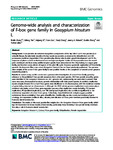Genome-wide analysis and characterization of F-box gene family in Gossypium hirsutum L
| dc.contributor.author | Zhang, S | |
| dc.contributor.author | Tian, Z | |
| dc.contributor.author | Li, H | |
| dc.contributor.author | Guo, Y | |
| dc.contributor.author | Zhang, Y | |
| dc.contributor.author | Roberts, Jeremy | |
| dc.contributor.author | Zhang, X | |
| dc.contributor.author | Miao, Y | |
| dc.date.accessioned | 2020-08-03T14:30:21Z | |
| dc.date.issued | 2019-12-19 | |
| dc.identifier.issn | 1471-2164 | |
| dc.identifier.issn | 1471-2164 | |
| dc.identifier.other | 993 | |
| dc.identifier.uri | http://hdl.handle.net/10026.1/16124 | |
| dc.description.abstract |
Background F-box proteins are substrate-recognition components of the Skp1-Rbx1-Cul1-F-box protein (SCF) ubiquitin ligases. By selectively targeting the key regulatory proteins or enzymes for ubiquitination and 26S proteasome mediated degradation, F-box proteins play diverse roles in plant growth/development and in the responses of plants to both environmental and endogenous signals. Studies of F-box proteins from the model plant Arabidopsis and from many additional plant species have demonstrated that they belong to a super gene family, and function across almost all aspects of the plant life cycle. However, systematic exploration of F-box family genes in the important fiber crop cotton (Gossypium hirsutum) has not been previously performed. The genome-wide analysis of the cotton F-box gene family is now possible thanks to the completion of several cotton genome sequencing projects. Results In current study, we first conducted a genome-wide investigation of cotton F-box family genes by reference to the published F-box protein sequences from other plant species. 592 F-box protein encoding genes were identified in the Gossypium hirsutume acc.TM-1 genome and, subsequently, we were able to present their gene structures, chromosomal locations, syntenic relationships with their parent species. In addition, duplication modes analysis showed that cotton F-box genes were distributed to 26 chromosomes, with the maximum number of genes being detected on chromosome 5. Although the WGD (whole-genome duplication) mode seems play a dominant role during cotton F-box gene expansion process, other duplication modes including TD (tandem duplication), PD (proximal duplication), and TRD (transposed duplication) also contribute significantly to the evolutionary expansion of cotton F-box genes. Collectively, these bioinformatic analysis suggest possible evolutionary forces underlying F-box gene diversification. Additionally, we also conducted analyses of gene ontology, and expression profiles in silico, allowing identification of F-box gene members potentially involved in hormone signal transduction. Conclusion The results of this study provide first insights into the Gossypium hirsutum F-box gene family, which lays the foundation for future studies of functionality, particularly those involving F-box protein family members that play a role in hormone signal transduction. | |
| dc.format.extent | 993- | |
| dc.format.medium | Electronic | |
| dc.language | en | |
| dc.language.iso | en | |
| dc.publisher | Springer Science and Business Media LLC | |
| dc.subject | Gossypium hirsutum L. | |
| dc.subject | Cotton | |
| dc.subject | F-box gene family | |
| dc.subject | Ubiquitination | |
| dc.subject | Protein degradation | |
| dc.title | Genome-wide analysis and characterization of F-box gene family in Gossypium hirsutum L | |
| dc.type | journal-article | |
| dc.type | Journal Article | |
| plymouth.author-url | https://www.webofscience.com/api/gateway?GWVersion=2&SrcApp=PARTNER_APP&SrcAuth=LinksAMR&KeyUT=WOS:000508020900001&DestLinkType=FullRecord&DestApp=ALL_WOS&UsrCustomerID=11bb513d99f797142bcfeffcc58ea008 | |
| plymouth.issue | 1 | |
| plymouth.volume | 20 | |
| plymouth.publication-status | Published | |
| plymouth.journal | BMC Genomics | |
| dc.identifier.doi | 10.1186/s12864-019-6280-2 | |
| plymouth.organisational-group | /Plymouth | |
| plymouth.organisational-group | /Plymouth/REF 2021 Researchers by UoA | |
| plymouth.organisational-group | /Plymouth/REF 2021 Researchers by UoA/UoA06 Agriculture, Veterinary and Food Science | |
| plymouth.organisational-group | /Plymouth/Users by role | |
| plymouth.organisational-group | /Plymouth/Users by role/Academics | |
| plymouth.organisational-group | /Plymouth/Users by role/Researchers in ResearchFish submission | |
| dc.publisher.place | England | |
| dcterms.dateAccepted | 2019-11-30 | |
| dc.rights.embargodate | 2020-8-6 | |
| dc.identifier.eissn | 1471-2164 | |
| dc.rights.embargoperiod | Not known | |
| rioxxterms.versionofrecord | 10.1186/s12864-019-6280-2 | |
| rioxxterms.licenseref.uri | http://www.rioxx.net/licenses/all-rights-reserved | |
| rioxxterms.licenseref.startdate | 2019-12-19 | |
| rioxxterms.type | Journal Article/Review |


